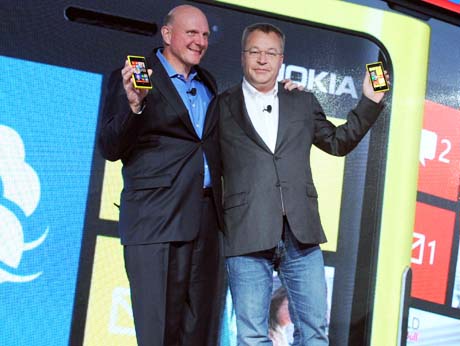
September 3 2013: A quarter century after it launched its mobile phone business by launching one of the world's first cellular handsets, Nokia, the Finland -based company that dominated the global portable telecom business like a colossus for over a decade, has gone into the history books. On Tuesday, it announced that it plans to sell " substantially all" of its handset and services business and all its patents in this arena, to Microsoft for the equivalent of $ 7.2 billion.
The dominant mobile phone brand worldwide from 1998 to 2012 -- and in India, the 'first phone' of millions who enjoyed the thrills of personal connectivity with a chunky Nokia handset -- the brand slowly ceded pole position to other aggressive players like Samsung. "Nokia deejiye!" -- "give me a Nokia" as a synonym for a mobile phone -- was a real catchphrase in India for millions on the other side of the so-called digital divide whose first exciting steps to self empowerment through telecom was powered by a Nokia handset -- suitably beefed up in India, with a torch. The company innovated in many ways -- I met one of their ethnographers, Jan Chipchase, a few years ago, who spent 6 months in the shanty town of Dharavi in Mumbai to understand how the poor hoped to lift themselves up with a personal phone. Why did so many Indian carry their phones in their shirt pockets rather than in their pant pockets? Well, research told Nokia that many Indians didn't wear pants but a dhoti which did not have a pocket! Such was Nokia's earthily realistic approach to selling phones. It also took a bold decision to manufacture some of its phones in India at a time when few telecom players dared or cared to do so. That put the sleepy town of Sriperumbudur near Chennai on the global manufacturing map.
Sadly Nokia did not see the signs of changing customer preference, fast enough: They were very late in responding to the Indian need for dual SIM phones and ceded precious lead to desi players like Micromax, Karbonn, Lava...
Through most of these years, Nokia in India was led by D Shivakumar -- 'Shiva' to his friends -- a great leader and a great guy who was, in my opinion, unfairly blamed by some elements of the Indian media for the brand's slide in this country. Having moved to a broader responsibility for Middle East Africa and India, Shiva finally left Nokia only 3 months ago.
We salute a great company and a great brand, of the Internet Age in our Image of the Day section
But we are also a little intrigued by this sequence of events:
1. Stephen Elop comes to Nokia in September 2010, as its first non Finnish CEO, from his previous job as Head of Microsoft's Business Division.
2. In 2011 he abandons Nokia's Symbian OS and makes Windows the operating system of all Nokia phones. This does not help boost sales.
3. In 2012, Microsoft expresses interest to buy Nokia's phone business even as Elop and Microsoft CEO Steve Ballmer launch Nokia's first Windows 8 device.
4. In 2013, Microsoft buys Nokia -- and Elop is effectively back where he started -- at Microsoft .
Make of that what you will! -- Anand Parthasarathy in Bangalore